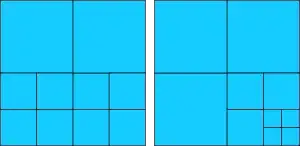Short answer: in general there is no solution to your problem. Below I explain this a bit, and give some possible ideas for compromises.
Ok, let's assume that all aspect ratios are the same (the tiles and the region to be tiled.) For simplicity, let's work with a square (you can stretch the solution afterward to the correct aspect ratio.)
The problem is now to find tiling of a square using $n$ squares, with areas given (really, their relative areas are given, but since they must sum to the area of the big square, we can work out what they are.)
It is known that a square cannot be tiled by 2, 3, or 5 squares. (It is not too hard to prove for 2 and 3, not so sure about 5; you can give it a go.) For 4 squares, there is only one layout: all the squares are the same size (so you cannot present channels with different importance using this scheme if there are only 4).
There is a layout for any number of squares if there are 6 or more. (See my answer here that proves that.)
In general there are several possibilities for each $n$, but we cannot match arbitrary areas. For example, the solution for 6 squares we must have 5 squares that have area $1/4$ of the big square. For 10 squares, there are these two schemes. (I haven't verified that these are the only ones but I think so).

In any case, so for $n$ you have a few possible layouts; how do you decide which to use?
Simple ranking: In this scheme, you maximize the variance in square sizes, and then simply assign the biggest channel to the biggest square, and so on. To maximize the variance in square sizes, follow this algorithm:
Start with one of the following layouts depending on value of $n \bmod 3$ (the first if it is 0, the second if it is 1, the third if it is 2). Keep dividing the smallest square into 4 until you have enough total squares.

Optimization Algorithm: In this scheme, you will find the "best" solution in some sense. However, you first need to define what the "best" means for you.
One way to do it is to define an error value for a layout:
$E = \sum_i (a_i - c_i)^2,$
where $a_i$ is the actual area you want, and $c_i$ is the area of the square in the layout you assign to represent it (again, you can match biggest squares to biggest channels). You can then choose the layout scheme that minimizes this value.
This will require you to find all possible layouts for a given $n$. An algorithm for this is to find tilings of squares by squares of size $1, 2, ..., \lceil\sqrt{n}\,\rceil$ and reject solutions that use the wrong number of squares. This may be unfeasible for very large $n$, and slow even for smaller $n$. You would probably need to make a database of solutions so you dont have to generate them each time (although I have no idea how many there are; space may become the next problem).
Best of $k$ guesses: An alternative is to generate $k$ randomish solutions using the scheme I described under ranking, but instead of choosing the smallest square each time, you choose a random one. This algorithm is very fast, so you can generate 100 (or a 1000) quickly, and select the best one using the error. (Since it will be an approximation in any case, this will be more than enough accuracy for your use case.) This is the solution I would use in the real world.


These types of problems are extremely hard, if you want this for a practical application, you may also want to add what types of compromises you can live with as an exact solution is unlikely.
– Herman Tulleken Dec 21 '19 at 00:24